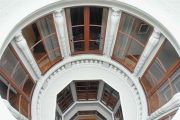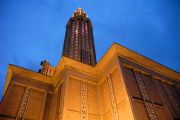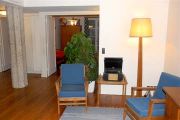One of the most important European ports, Le Havre boasts the second largest collection of Impressionist paintings after Paris. Destroyed during WWII, the city retains only a few historic building but is famous for its modern architecture.
[ Practical ]
Getting there
- By road
200 km from Paris on autoroutes A14, A13 and A131.
- By train
ntercités train from Paris Saint-Lazare to Le Havre. The journey takes 2 h.
- By ferry
Ferry Le Havre - Portsmouth
Lodging
Art Hôtel
Oscar Hôtel
Hôtel Vent d’Ouest
Hôtel Pasino
Hôtel Carmin
Novotel Le Havre Bassin Vauban
Restaurants
Le Lyonnais
Le Roi Léopold à Sainte-Adresse
La Voile Bleue
Le Bistrot d’Antan
Taverne Paillette
Jean Luc Tartarin
Closerie des Grands Bassins
La Petite Auberge
Historic show flat
181 rue de Paris, 76000 Le Havre
Guided tours on Wednesdays, Saturdays and Sundays at 2pm, 3pm, 4pm and 5pm
Admission : €3, free for under 26s
Tel : 0235223122
Dubocage de Bléville Mansion
1 rue Jérome Bellarmato
Open Wednesday from 2pm to 6pm, Thursday to Monday from 11am to 12.30pm and from 1.30pm to 6pm.
Admission : €5
Tel : 023542270
Ship Owner Mansion
3 quai de l’Ile
Open Wednesday from 2pm to 6pm, Thursday to Monday from 11am to 12.30pm and from 1.30pm to 6pm.
Admission : €5, free for under 26s
Tel : 0235190985
MuMa
2 boulevard Clémenceau
Open every day except Tuesday from 11am to 6pm, till 7pm on Saturday and Sunday.
Admission : €5, free for under 26s
Tel : 0235196262
Hanging gardens
Open every day from 10.30am to 8pm from April to September, from 10.30am to 6pm in March and October, from 10.30am to 5pm from November to February.
Admission free
Information
- Seine-Maritime Tourist Office
0235121010
www.seine-maritime-tourisme.com
- Le Havre Tourist Office
Tel : 0232740404
www.lehavretourisme.com
Located on the right bank of the Seine estuary, Le Havre is a relatively young city founded in 1517 by King Francis 1st to replace the nearby port of Harfleur that was silting up. Initially called “Le Havre de Grâce”, hence its present name, it was first a military port but it quickly flourished thanks to transatlantic trade. In 1604, Samuel Champlain sailed away from there to his second trip to North America during which he founded the first colonies in Canada.

 Dubocage de Bléville Mansion © T.Joly Dubocage de Bléville Mansion © T.Joly
|
 Historic houses Historic houses
At the end of the 18th century, that’s also from La Havre that were shipped most of the supplies provided to American insurgents during the War of Independence. Then, from the mid 19th century, it became one of the leading European ports in transatlantic freight and passengers traffic. Famous Ocean liners such as the Normandie and the France regularly docked there carrying celebrities like Alfred Hitchcock, Ernest Hemingway or Salvador Dali. Nowadays, around hundred cruise ships stop in the port every year.
Two historic houses located along the quays remind of this rich maritime past. One is the Dubocage de Bléville mansion, a 17th century building bearing the name of a powerful ship owner who, in 1711, discovered the Passion Island, later renamed Clipperton Island by British. Turned into a museum, it houses an eclectic collection of ancient items, reminiscent of a cabinet of curiosities.

 Ship Owner Mansion © T.Joly Ship Owner Mansion © T.Joly
|
 Ship owner mansion Ship owner mansion
It also evokes the development of Le Havre in tandem with changes in navigation and science. The second one is the Ship Owner’s Mansion, a four floors house built in the late 18th century with a very unusual interior as rooms are structured around a central well of light. Some are reconstructions of the private apartments, office and library of a wealthy merchant of Le Havre while other hold objects and documents about the story of the city and its port.
Nearby, have also a look at the astonishing “Salon des Navigateurs”, both a hairdressing salon and a museum presenting ancient hairdresser tools as well as marine objects. You can get there just for a visit or get your hair cut in amid ancient hairdressing tools, ship scale models, sailor uniforms, liners memorabilia and many other curiosities.
 A unique example of post war architecture A unique example of post war architecture
Apart the Saint François church and the Notre Dame cathedral, a mix of gothic and Renaissance styles, the city has almost no other historical monuments.
During WWII, it indeed suffered no less than 146 bombardments including 132 by Allied Air Forces. The last ones, done by the British between September 5 and 13th 1944 to oust German forces, were so violent that hardly a brick was left standing between the railway station and the waterfront, 2 km away !!!!
The city centre reconstruction was entrusted to the workshop of French architect Auguste Perret, nicknamed the “wizard of reinforced concrete”, and lasted from 1945 to 1964. Due to its architectural coherence and size, 150 ha, this district is a unique example of post war architecture and town planning and was for this reason added to UNESCO’s world heritage list on 2005. Made up of towers, 3 to 5 floors condominiums and little tree-filled squares, it boasts four landmarks.

 Saint-Joseph Church © T.Joly Saint-Joseph Church © T.Joly
|
 Masterpiece of concrete architecture Masterpiece of concrete architecture
The city hall, consisting of a building with colonnade façade and a 70 m high tower, as well as the vast square where it stands. The Foch avenue, main thoroughfare of the district, supposedly wider than the Champs Elysees, that leads to the Ocean Gate where two 13 floors towers face the sea and symbolize the city gates. The Saint-Joseph Church dedicated to the memory of the victims of the bombing, a masterpiece of concrete architecture whose 107 m high spire rises up above the city and that is illuminated by natural light filtering through nearly 13 000 panes of coloured glass.
Make sure to visit the historic show flat as well. Comprising five rooms, it is similar to the one presented at the 1947 exhibition about plans for rehousing people and provides insights into the architect’s intention to create a space that was both rational and adaptable.

 Historic show flat © T.Joly Historic show flat © T.Joly
|
 Historic show flat Historic show flat
It contains everyday objects as well as lean and functional furniture by post-war interior decorators René Gabriel, Marcel Gascoin and André Beaudoin. Nearby, a heritage centre gives more information about Perret’s work.
But, modern architecture in Le Havre is not limited to his buildings. Nicknamed the Volcano due to its shape, the Art Centre was created by Brazilian architect Oscar Niemeyer, the designer of Brasilia. Facing it, an elegant 1969 footbridge by architect Guillaume Gillot spans one of the oldest basins of the port and the former stock exchange, now a casino, standing on the quay is a 1957 work by Otello Zavaroni. In 2012, a stadium with a futuristic architectural design, the Oceane stadium, was inaugurated. In 2010, a student housing complex called “Cité A Docks” was made out of old shipping containers by Italian architect Alberto Cattani.
 Beautiful aquatic centre Beautiful aquatic centre
A complex of timber-framed brick buildings connected by glass-roofed courtyards originally used to store imported coffee, tobacco and cotton, the late 19th century – early 20th century Docks Vauban have been turned into a modern shopping mail. They are located between the Vauban and Vatine basins where are moored leisure boats and in the same area stands what is probably one of architect Jean Nouvel’s most beautiful creations, the Bains des Docks. According to him, based on the concept of the Roman Baths, this uncluttered aquatic centre in pastel colours offers an outdoor Olympic swimming pool, indoor pools with jacuzzi and water jets, a fitness centre and a well-being area with hamman.
Lastly, overlooking the harbour entrance, the Andre Malraux Modern Art Museum (MuMa) is a beautiful glass, iron and aluminium building inaugurated in 1961 and then France’s first House of Culture.
 A museum with a rich collection A museum with a rich collection
Thanks to several donations, it now possesses more than 250 Impressionist paintings, the second largest collection after Orsay Museum, hundreds of works by Eugène Boudin as well as dozen of canvases by Raoul Dufy and Fauves artists. If this museum has such a collection, it’s partly because several late 19th century and early 20th century wealthy ship owners from Le Havre were also art connoisseurs and assembled large private collections. Besides, as Le Havre was linked to Paris by railway since 1847, many Impressionist painters come to visit the town. In particular Claude Monet who had an aunt living there and painted his famous canvas “Impression Rising Sun” from the quay of the port. Another favourite source of inspiration for artists was the pebble beach the city shares with the adjacent seaside resort of Sainte-Adresse.
 Seaside resort Seaside resort
A very fashionable place at the turn of the 20th century, it keeps some beautiful Belle Epoque villas surrounded by gardens. However, many of them have been destroyed during the war and gave place to modern houses. The resort ends at the foot of spectacular cliffs and there are several viewpoints over the beach and Le Havre from its heights as well as from the Saint-Adresse fort. Built in the 19th century in a Vauban style, disused from 1945, it now houses the Hanging Gardens. Set on its bastion and in green houses occupying its courtyard, they pay homage to Norman explorers who introduced in Europe numerous botanical species. They features plants from all over the world, particularly from the Southern hemisphere, East Asia and North America.
From there, Le Havre historical centre seems far away but a funicular allows pedestrians to reach it very quickly.

 FishermenLe Havre © T.Joly FishermenLe Havre © T.Joly
|
 Fresh scallops Fresh scallops
To end your visit, if you want to get an idea of what did the city look like before the bombardments, go to its outskirts to stroll around the former Harfleur. A signposted itinerary allows you to discover 15th, 17th and 18th century houses, one of Normandy most beautiful religious buildings, the Saint-Martin church built between the 13th and 16th centuries, a small 17th century stone and brick castle being now the city hall and the Prieuré Museum that houses Roman pottery and glass as well as contemporary art.
And if you are a gourmet, don’t leave Le Havre without going back near the Ship’s Owner mansion where fishermen have stands where they sell at bargain prices fresh fishes and scallops.
January 26, 2013
Thierry Joly 

|



